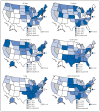Invasive cancer incidence and survival--United States, 2011
- PMID: 25763875
- PMCID: PMC5779605
Invasive cancer incidence and survival--United States, 2011
Abstract
Because of improvements in early detection and treatment of cancer, the proportion of persons with cancer who survive ≥5 years after diagnosis has increased. To assess progress toward achieving Healthy People 2020 objectives,* CDC analyzed data from U.S. Cancer Statistics (USCS) for 2011, the most recent data available. USCS includes incidence and survival data from CDC's National Program of Cancer Registries (NPCR) and the National Cancer Institute's Surveillance, Epidemiology, and End Results (SEER) program and mortality data from the National Vital Statistics System. In 2011, a total of 1,532,066 invasive cancers were reported to cancer registries in the United States (excluding Nevada), for an annual incidence rate of 451 cases per 100,000 persons. Cancer incidence rates were higher among males (508) than females (410), highest among black persons (458), and ranged by state, from 374 to 509 per 100,000 persons (339 in Puerto Rico). The proportion of persons with cancer who survived ≥5 years after diagnosis was 65% and was similar among males (65%) and females (65%) but lower among black persons (60%) compared with white persons (65%). Surveillance of cancer incidence and survival are essential for identifying population groups with high cancer incidence rates and low cancer survival rates as well as for estimating the number of cancer survivors, which was 13.7 million in 2012. These data are being used by states to effectively develop comprehensive cancer control programs, including supporting the needs of cancer survivors.
Figures
References
-
- US Department of Health and Human Services. Healthy People 2020. Available at http://www.healthypeople.gov/2020/topicsobjectives2020/default.aspx. - PubMed
-
- US Cancer Statistics Working Group. United States Cancer Statistics: 1999–2011 incidence and mortality web-based report. Available at http://www.cdc.gov/uscs.
-
- Hewitt M, Greenfield S, Stovall E, editors. From cancer patient to cancer survivor: lost in transition. Washington, DC: The National Academies Press; 2005.
MeSH terms
LinkOut - more resources
Full Text Sources


